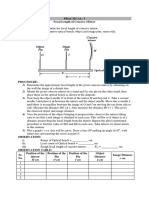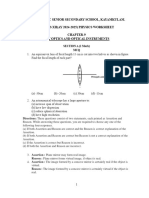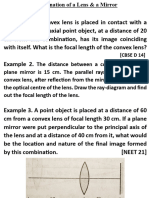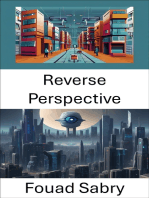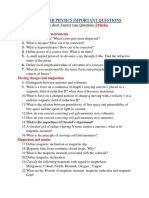15 Refraction of Light. (Sheet - 4)
15 Refraction of Light. (Sheet - 4)
Uploaded by
Shabd wadhwa 9cCopyright:
Available Formats
15 Refraction of Light. (Sheet - 4)
15 Refraction of Light. (Sheet - 4)
Uploaded by
Shabd wadhwa 9cOriginal Title
Copyright
Available Formats
Share this document
Did you find this document useful?
Is this content inappropriate?
Copyright:
Available Formats
15 Refraction of Light. (Sheet - 4)
15 Refraction of Light. (Sheet - 4)
Uploaded by
Shabd wadhwa 9cCopyright:
Available Formats
Refraction of Light ( Numerical Problem)
Sheet –
Fun
ics is
Phys
Refraction of Light
(Numerical Problems)
52. A lens forms a real image of an object. The distance of the object to the lens is u cm and the
distance of the image from the lens is v cm. The given graph shows the variation of v with u.
(i) What is the nature of the lens?
(ii) Using this graph, find the
(iii) focal length of this lens. (Ans. f= + 10 cm)
53. A needle placed 45 cm from a lens forms an image on a screen placed 90cm on the other
side of the lens. Identify the type of the lens and determine its focal length. What is the
size of image if the size of the needle is 5.0 cm? [30cm,-10cm]
54. Converging light rays are falling on a convex lens as shown in Fig.. if the focal length of
the lens is 30 cm, then find the position of the image. (Ans. v = + 7.5 cm)
55. A needle 10 cm long is placed along the axis of a convex lens of focal length 10 cm such
that the middle point of the needle is at a distance of 20 cm from the lens. Find the length
of the image of the needle.
56. At what distance should an object be placed from a convex lens of focal length 15 cm to
obtain an image three times the size of the object?
[20cm for real image ,10cm for virtual image]
57. An object is placed at a distance of 1.5 m from a screen and a convex lens is interposed
between them. The magnification produced is 4. What is the focal length of the lens?
(Ans. 0.24 m)
6 Compiled by : Nikhil Saxena 9411916889
Refraction of Light ( Numerical Problem)
58. Find the position of the image formed by the lens shown in the Fig. Another lens is placed
in contact with this lens to shift the image further away from the lens. What is the nature
of the second lens? [15 cm, concave lens]
59. The following data was recorded for values of object distance and the corresponding val-
ues of image distance in the experiment on study of real image formation by a convex lens
of power + 5 D. One of these observation is incorrect. Identify this observation and give
reason for your choice.
Sr. No. Object distance (cm) Image distance (cm)
1. 25 97
2. 30 61
3. 35 37
4. 45 35
5. 50 32
6. 55 30
60. A converging beam of light forms a sharp image on a screen. A lens is placed in the path
of the beam at 10 cm from the screen. It is found that the screen has to be moved 8cm
further away from the lens to obtain a sharp image. Find the focal length and nature of the
lens. (Ans. - 22.5 cm, concave)
61. A convergent lens of power 8 D is combined with a divergent lens of power- 10 D. Calcu-
late focal length of the combination. (Ans. - 0.5 m)
62. In the following ray diagram are given the positions of an object 0, image I and two lenses
L1 and L2. The focal length of L1 is also given. Find the focal length of L2. (Ans. f = - 15 cm)
63. From the ray diagram shown below, calculate the focal length of the concave lens.
(Ans. f = - 20 cm)
64. A convex lens of focal length 10 cm is placed coaxially 5cm away from a concave lens of
focal length 10cm. If an object is placed 30 cm in front of the convex lens, find the position
of the final image formed by the combined system. [at infinity]
7 Compiled by : Nikhil Saxena 9411916889
Refraction of Light ( Numerical Problem)
65. In the diagram shown below, rays are coming from infinity and after passing through
both the lenses meet on a screen placed at a distance of 30 cm from the concave lens.
Calculate the focal length of the concave lens. (Ans. 15 cm)
66. In the following ray- diagram are shown the positions of the object 0, image I, two lenses
and a plane mirror. The focal length of one of the lenses is also given. Calculate the focal
length of the other lens. (Ans. 20 cm)
67. Fig. shows on equiconvex lens (of refractive index 1.50) in con-
tact with a liquid layer on top of a plane mirror. A small needle
with its tip on the principal axis is moved along the axis until its
inverted image is found at the position of the needle. The dis-
tance of the needle from the lens is measured to be 45.0 cm. The
liquid is removed and the experiment is repeated. The new dis-
tance is measured to be 30.0 cm. What is the refractive index of
the liquid? [1.33]
68. Find the position of the image formed by the lens combination given in Fig. below: [30cm]
69. An equiconvex lens of focal length 15 cm is cut into two equal halves along its length.
What is the focal length of each half ? (Ans. 30 cm)
70. The following data was recorded for values of object distance and the corresponding val-
ues of image distance in the experiment on study of real image formation by a convex lens
of power +5D. One of these observations is incorrect. Identify this observation and give
reason for your choice: [Ans. 20 cm, both are the between f and 2f].
8 Compiled by : Nikhil Saxena 9411916889
Refraction of Light ( Numerical Problem)
S. No. 1 2 3 4 5 6
Object distance (cm) 25 30 35 45 50 55
Image distance (cm) 97 61 37 35 32 30
71. Find the position of the image formed of an object ‘O’ by the lens combination given in the
figure. [Ans. at a distance 30 cm to the right of third lens]
72. You are given three lenses L1, L2 and L3 each of focal length 20 cm. An object is kept at 40
cm in front of L1, as shown. The final real image is formed at the focus ‘I’ of L3. Find the
separations between L1, L2 and L3.
[Ans. L1 which lies 20 cm of lens L2 i.e., focus of lens L2, the distance between L1 and L2
= 40 + 20 = 60 cm, the distance between L2 and L3 can have any value]
9 Compiled by : Nikhil Saxena 9411916889
You might also like
- Worksheet CBSE Class 10 LightDocument6 pagesWorksheet CBSE Class 10 Lightroythomasc50% (4)
- TUTO 1 Geometrical OpticsDocument10 pagesTUTO 1 Geometrical OpticsTuyenITNo ratings yet
- Fabry-Perot InterferometerDocument6 pagesFabry-Perot InterferometerChandan ThakurNo ratings yet
- 16 Prims & Optical Instruments (Numbercial Problems) - (Sheet - 2)Document2 pages16 Prims & Optical Instruments (Numbercial Problems) - (Sheet - 2)Shabd wadhwa 9cNo ratings yet
- Extra Questions - Refraction - Lens - Answers - 230610 - 042208Document5 pagesExtra Questions - Refraction - Lens - Answers - 230610 - 042208Zoha AzizNo ratings yet
- Numericals Lens FormulaDocument1 pageNumericals Lens Formulamukeshsgf5No ratings yet
- Focal Length of Concave MirrorDocument2 pagesFocal Length of Concave MirrorniteshNo ratings yet
- Light QuestionsDocument2 pagesLight Questionsilyas aliNo ratings yet
- Numericals LightDocument2 pagesNumericals Lightmukeshsgf5No ratings yet
- X - Science - Physics - CH-9 Light - Assignment-3Document1 pageX - Science - Physics - CH-9 Light - Assignment-3Shweta DuhanNo ratings yet
- Ay Optics Practice QuesDocument9 pagesAy Optics Practice QuesBAAP ka papaNo ratings yet
- Ch-9 Science PYQsDocument11 pagesCh-9 Science PYQsglusac261No ratings yet
- Light QuestionsDocument9 pagesLight QuestionsTxv RushNo ratings yet
- Assignment 3 - RefractionDocument4 pagesAssignment 3 - RefractionoshnamittalschoolNo ratings yet
- Worksheet - Class 10th ScienceDocument5 pagesWorksheet - Class 10th Sciencekaniga127No ratings yet
- Exercise 22Document4 pagesExercise 22Nafa HashimNo ratings yet
- Class - 10 - Light - NumericalsDocument6 pagesClass - 10 - Light - Numericalsray63% (8)
- Chapter 9 Ray Optics and Optical InstrumentsDocument3 pagesChapter 9 Ray Optics and Optical Instrumentshitharesmi07No ratings yet
- Adobe Scan 11 Sept 2024 (1)Document2 pagesAdobe Scan 11 Sept 2024 (1)bloggingtipshindi4No ratings yet
- Adobe Scan 13 Nov 2024Document8 pagesAdobe Scan 13 Nov 2024shubhamkeshri2457No ratings yet
- Multiple Element Optical Systems: O4.1 IntroductionDocument10 pagesMultiple Element Optical Systems: O4.1 IntroductionMohanth MohantyNo ratings yet
- Asm 18667Document7 pagesAsm 18667sharmaa9212705357No ratings yet
- Light Board QuestionsDocument5 pagesLight Board Questionsafraz.arshiNo ratings yet
- Physics 30 Lesson 9 Optics - Thin Lenses: Refraction 2 Refraction 1Document11 pagesPhysics 30 Lesson 9 Optics - Thin Lenses: Refraction 2 Refraction 1John JohnsonNo ratings yet
- Tut 2 Optics - Tel S2ay2018Document2 pagesTut 2 Optics - Tel S2ay2018Monisha DasarathanNo ratings yet
- Optics Numericals - 33068016 - 2024 - 09 - 29 - 10 - 42Document5 pagesOptics Numericals - 33068016 - 2024 - 09 - 29 - 10 - 42A New Way of learningNo ratings yet
- Mirror FormulaDocument18 pagesMirror FormulaManoj KumarNo ratings yet
- Ray Optics 4Document2 pagesRay Optics 4AryaNo ratings yet
- PS - CB - X - Sci - Light - Reflection and RefractionDocument7 pagesPS - CB - X - Sci - Light - Reflection and Refractionatharvathange0No ratings yet
- LIGHT-PAST PAPER QnsDocument6 pagesLIGHT-PAST PAPER QnsARSHAD JAMIL100% (1)
- Adobe Scan 12-Dec-2024 (2)Document2 pagesAdobe Scan 12-Dec-2024 (2)kirubadithacsNo ratings yet
- Light_ Reflection and RarefactionDocument4 pagesLight_ Reflection and RarefactionitsmekeshavmongiaNo ratings yet
- 9 - 2024 - RAY OPTICS - ASSIGNMENT - 83 - 84 ( COMPOUND MICROSCOPE ) - PDFDocument4 pages9 - 2024 - RAY OPTICS - ASSIGNMENT - 83 - 84 ( COMPOUND MICROSCOPE ) - PDFrathi.shreyanshi1No ratings yet
- Light Worksheet HHWDocument4 pagesLight Worksheet HHWananyaanish19No ratings yet
- Practice Worksheet Light (Reflection-Mirror)Document3 pagesPractice Worksheet Light (Reflection-Mirror)[ [ ] ] SARTHAK SHINDENo ratings yet
- CBSE Class 10 Physics WorksheetDocument2 pagesCBSE Class 10 Physics WorksheetRaghav Gupta100% (2)
- CBSE Class 10 Physics Worksheet PDFDocument2 pagesCBSE Class 10 Physics Worksheet PDFhiteshNo ratings yet
- Light-Practice SheetDocument4 pagesLight-Practice Sheetyash.sharmamsiNo ratings yet
- Light - Reflection and RefractionDocument2 pagesLight - Reflection and Refractiongamingfreak638No ratings yet
- Mirrors and LensesDocument27 pagesMirrors and Lensesplease360No ratings yet
- Reflection and RefractionDocument4 pagesReflection and Refractionsamwork469No ratings yet
- Class 10 - CH 9 - Light - Reflection and Refraction - PYQDocument13 pagesClass 10 - CH 9 - Light - Reflection and Refraction - PYQswarajpatil180No ratings yet
- PHY250 Tutorial 1.2 (Lens)Document3 pagesPHY250 Tutorial 1.2 (Lens)Amar ArbainNo ratings yet
- Light - Reflection and Rarefaction (Assignment)Document2 pagesLight - Reflection and Rarefaction (Assignment)amit mongiaNo ratings yet
- Physics PodarDocument12 pagesPhysics PodarRuthvikNo ratings yet
- 92356191 Bansal CLasses Physics Study Material for IIT JEE 252 265Document14 pages92356191 Bansal CLasses Physics Study Material for IIT JEE 252 265Chirag AroraNo ratings yet
- Lens and Mirror NumericalsDocument1 pageLens and Mirror Numericalssiyakshetri11No ratings yet
- 2 PhyDocument2 pages2 Physwatiaps412No ratings yet
- Class-10 Reflection and RefractionDocument17 pagesClass-10 Reflection and RefractionKuldeep SinghNo ratings yet
- Combination of Lens & A MirrorDocument9 pagesCombination of Lens & A MirrorManoj KumarNo ratings yet
- C10 Physics Light Test 3 QDocument6 pagesC10 Physics Light Test 3 Qdhanvanth dhanvanthNo ratings yet
- LIGHT- REFLECTION AND REFRACTIONDocument19 pagesLIGHT- REFLECTION AND REFRACTIONhasinihari2418No ratings yet
- Light WorksheetDocument5 pagesLight Worksheetsdivy051No ratings yet
- Light Reflection NumericalsDocument2 pagesLight Reflection Numericalspmagrawal100% (2)
- DPP 1 Light 2023Document10 pagesDPP 1 Light 2023kaushalgomziNo ratings yet
- FileDocument167 pagesFilegingeristhebestcattoeverexistNo ratings yet
- DOC-20240822-WA0011.Document6 pagesDOC-20240822-WA0011.afraz.arshiNo ratings yet
- Reflection of Light - WorksheetDocument5 pagesReflection of Light - WorksheetDøomNo ratings yet
- 5+mark+questions +CBSE+X +light +25 12 2019 PDFDocument45 pages5+mark+questions +CBSE+X +light +25 12 2019 PDFPiyushNo ratings yet
- Optics and Optical Instruments: An IntroductionFrom EverandOptics and Optical Instruments: An IntroductionRating: 4 out of 5 stars4/5 (5)
- Reverse Perspective: Reimagining Visual Perception in Computer VisionFrom EverandReverse Perspective: Reimagining Visual Perception in Computer VisionNo ratings yet
- Lab 4 Linear Polarization (April 2006)Document10 pagesLab 4 Linear Polarization (April 2006)Anonymous QrHxJ4No ratings yet
- Why Anti Rads Glasses Is ImportantDocument1 pageWhy Anti Rads Glasses Is ImportantGiovanni BallogNo ratings yet
- Near FieldDocument5 pagesNear FieldfghjhgfNo ratings yet
- All Subject Previous Year Question Paper (4th Sem)Document34 pagesAll Subject Previous Year Question Paper (4th Sem)Saroj kumar BiswasNo ratings yet
- Antenna Theory - Parabolic ReflectorDocument6 pagesAntenna Theory - Parabolic ReflectorSwatilekha ChowdhuryNo ratings yet
- Ep310 DatasheetDocument1 pageEp310 DatasheetCamilo Restrepo CroNo ratings yet
- Simulation of Brushless DC Motor Speed Control in Matlab-Ijaerdv04i1290151Document7 pagesSimulation of Brushless DC Motor Speed Control in Matlab-Ijaerdv04i1290151Wairokpam DhanrajNo ratings yet
- Reflection and RefractionDocument27 pagesReflection and RefractionEstelaBenegildoNo ratings yet
- UNIT 3 Material ScienceDocument12 pagesUNIT 3 Material ScienceMohammed IqbalNo ratings yet
- Simple Dipole For 2m Band v11Document11 pagesSimple Dipole For 2m Band v11fox7878No ratings yet
- Laser and Fibre OpticsDocument25 pagesLaser and Fibre OpticsAnto PradeepNo ratings yet
- AC Generator TheroryDocument11 pagesAC Generator TheroryM Kumar MarimuthuNo ratings yet
- Chapter 2 - Signal Degradation in Optical FiberDocument28 pagesChapter 2 - Signal Degradation in Optical FiberNgay Tro VeNo ratings yet
- Physics 326 - Optics and Laser Physics 2017Document123 pagesPhysics 326 - Optics and Laser Physics 2017Parthasarathi JoarderNo ratings yet
- Instrumental Techniques For Study of Orthodontic MaterialsDocument18 pagesInstrumental Techniques For Study of Orthodontic MaterialsSailusha BatchuNo ratings yet
- Reference BooksDocument3 pagesReference BooksAmitabhaNo ratings yet
- Buzzer & TIRDocument16 pagesBuzzer & TIRSachin Kumar50% (2)
- Electron Energy and LightDocument6 pagesElectron Energy and LightYuxin (Janice) ZhuNo ratings yet
- Solution3 HIT Optical FiberDocument10 pagesSolution3 HIT Optical FiberMichael NaymarkNo ratings yet
- Applied Nanophotonics Sergey V Gaponenko Download PDFDocument62 pagesApplied Nanophotonics Sergey V Gaponenko Download PDFnusjaratano100% (3)
- Course Outline For Introduction To MachineDocument3 pagesCourse Outline For Introduction To MachineyodaheNo ratings yet
- Pre-Test Period 1Document2 pagesPre-Test Period 1farhan lanangNo ratings yet
- GE Lighting Systems Lucalox Lighting Systems Brochure 4-81Document8 pagesGE Lighting Systems Lucalox Lighting Systems Brochure 4-81Alan MastersNo ratings yet
- End Sem Part A PDFDocument1 pageEnd Sem Part A PDFcharu tandonNo ratings yet
- Philips Professional Luminaires Price List W.E.F. 16-04-2012Document53 pagesPhilips Professional Luminaires Price List W.E.F. 16-04-2012Rouf Ahmed NajarNo ratings yet
- Physics 2 Yr Important QuestionDocument5 pagesPhysics 2 Yr Important QuestionyashwantNo ratings yet
- Case StudyDocument3 pagesCase StudyRogelio AquinoNo ratings yet
- Sky Wave PropagationDocument11 pagesSky Wave PropagationKethavath VenkateshNo ratings yet
- Psisdg 6770 1 67700H 1Document9 pagesPsisdg 6770 1 67700H 1Carlos Morales CarbajalNo ratings yet






